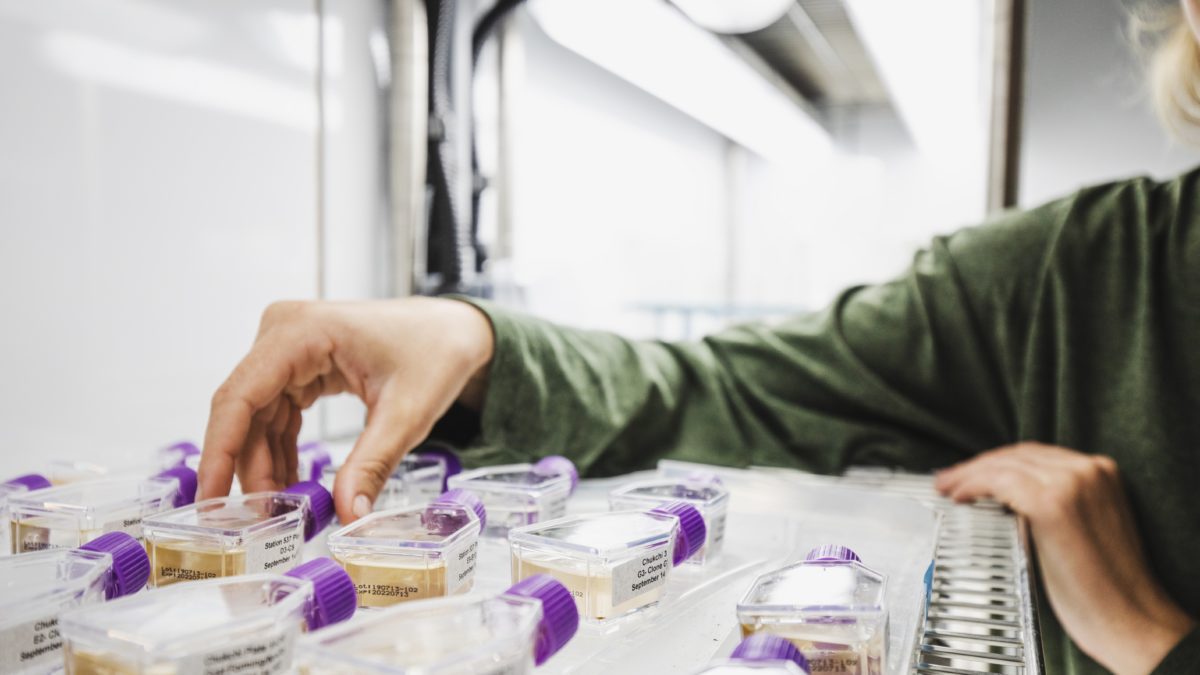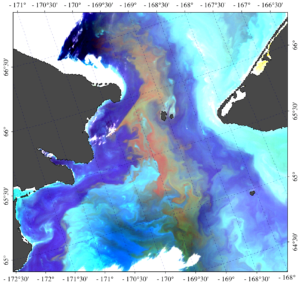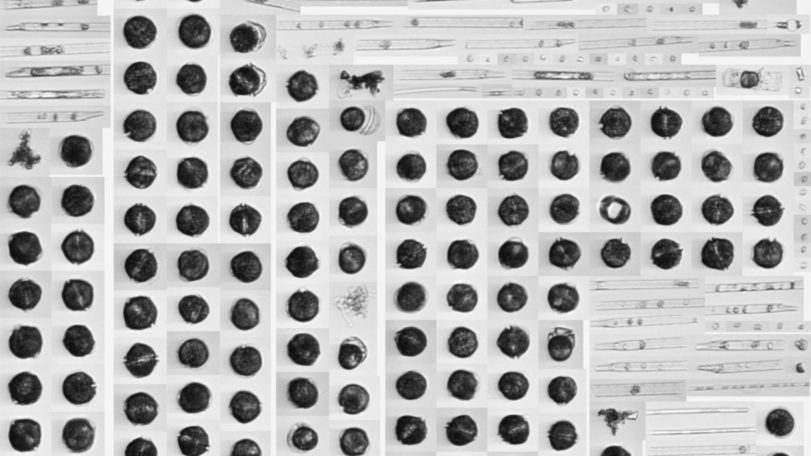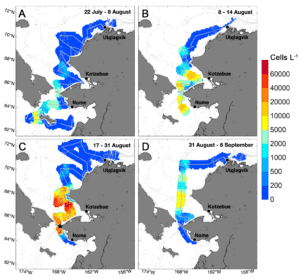The Detection of a Massive Harmful Algal Bloom in the Arctic Prompts Real-Time Advisories to Western Alaskan Communities
 WHOI-MIT Joint Program Student Evie Fachon arranges Alexandrium cultures in the incubator at WHOI’s Anderson Lab. (Photo by Daniel Hentz, ©Woods Hole Oceanographic Institution)
WHOI-MIT Joint Program Student Evie Fachon arranges Alexandrium cultures in the incubator at WHOI’s Anderson Lab. (Photo by Daniel Hentz, ©Woods Hole Oceanographic Institution) July 10, 2024
Woods Hole, Mass. -- In summer of 2022, a research cruise detected a massive harmful algal bloom (HAB) in the Bering Strait region of western Alaska. This expedition provided a dramatic example of science utilizing new technology to track a neurotoxic HAB, and effectively communicate information that protects remote coastal communities in real-time.
The large spatial scale, high cell density, long duration, and potent toxicity of the 2022 HAB event “posed an unprecedented risk to human and ecosystem health as well as maritime subsistence harvest activities in the Bering Strait region and beyond,” according to the journal article “Tracking a large-scale and highly toxic Arctic algal bloom: rapid detection and risk communication,” published in Limnology and Oceanography Letters.

A satellite image of the Bering Strait, taken August 2, 2022, with presence of the Alexandrium bloom appearing in red. (Photo by: Priscila Lange, ©Bigelow Laboratory for Ocean Sciences and Universidade Federale Rio de Janeiro)
Researchers from the Woods Hole Oceanographic Institution (WHOI) and its partners, noted that, to their knowledge, the 2022 event was the largest HAB event documented in polar waters to be caused by the single-celled organism Alexandrium catenella, which produces neurotoxins called paralytic shellfish toxins (PSTs). Toxins produced by this organism as it proliferates or “blooms” can accumulate in organisms that consume the algae, and the toxins can then be transferred through the food web causing illness or mortality of marine animals and potentially fatal Paralytic Shellfish Poisoning (PSP) in people who eat contaminated seafoods.
The bloom of Alexandrium stretched at least 600 kilometers (~370 miles) from the northern Bering Sea to the southern Chukchi Sea at its peak. While concentrations of A. catenella in excess of 1,000 cells per liter are considered dangerous, the measured maximum concentrations in this bloom exceeded 174,000 cells per liter – a record breaker for Arctic waters. In addition, the high toxicity of the Alexandrium cells compounded the poisoning risk from the bloom, according to the researchers.
The 2022 event “represented a striking example of northward bloom advection” – i.e., transport –“from subpolar waters, as well as eastward penetration into Alaskan Coastal waters due to local wind forcing. This mixing of nutrient-rich Bering Sea water with warm coastal waters likely fueled A. catenella growth and accumulation,” the article states. “As continued warming shifts the Pacific Arctic towards more favorable conditions for A. catenella blooms, comprehensive monitoring and response resources will be essential in mitigating the impacts of future bloom events.”
“A goal of this study is to bring more attention to some of the serious issues this region is facing, knowing that as climate changes and the Arctic continues to warm, it’s more likely that we are going to see blooms like this occurring in polar waters. We are hopeful that this research can motivate more robust testing and monitoring,” said journal article lead author Evie Fachon, a biologist and Ph.D. candidate in the Massachusetts Institute of Technology/WHOI Joint Program.

A dashboard image from the IFCB shows high concentrations of the Alexandrium (dark round cells) found in a Bering Strait water sample. (Photo by: Evie Fachon, ©Woods Hole Oceanographic Institution)
Fachon, who led the HAB team on the cruise, recalled watching from the research vessel R/V Norseman II as data came in from an Imaging FlowCytobot (IFCB), a robotic microscope that was configured to sample near-surface waters, collect imagery of the phytoplankton community along the cruise track, and enable real-time detection of the A. catenella bloom as it spread into Arctic waters during the course of two back-to-back cruise legs lasting a total of six weeks. “As we recorded the cell concentration getting higher and higher as the vessel tracked north, we knew we needed to provide that information to people in the region who could be impacted,” she said.
Working in collaboration with tribal and state governments and other regional hub community-based groups in Nome, a communications plan had proactively been planned, allowing for rapid situational awareness and public health precautions to be conveyed to people in remote areas.

(A map shows the progression of the Alexandrium bloom from July to September 2022. Cell density is illustrated by the color scale on the right. (Credit: Evie Fachon, ©Woods Hole Oceanographic Institution)
With many western and northern Alaskan coastal communities relying on a diverse array of marine resources for subsistence and commercial harvest activities, researchers and collaborators distributed risk advisories to tribal governments, regional media, and the public shortly after the 2022 bloom was detected. The efforts “mobilized a rapid and unprecedented regional response in an area with little experience of HABs, much less one of this magnitude,” the researchers noted.
Gay Sheffield, the Marine Advisory Program Agent for Alaska Sea Grant, recalled that within 24 hours of assisting with the first regional advisory, the tribally owned Norton Sound Health Corporation (NSHC) had its community-based health clinics on alert for symptoms of PSP, a novel human health risk to the Bering Strait region. Sheffield, a co-author of the journal article, was able to re-route a marine mammal carcass survey to alert people and provide educational as well as emergency response information on Little Diomede Island, which is in the middle of the Bering Strait between the Alaskan mainland and Chukotka, Russia. The community at Diomede Island was at the epicenter of the unprecedented high cell counts and high toxicity during the event. “I had just 15 minutes on the helipad to caution people to not harvest their primary subsistence seafoods such as walruses, bearded seals, clams, and tunicates and to provide people with printed advisory and educational materials. It was a difficult message to have to give – and certainly for the community to receive – regarding human health, food safety, and food security concerns.”
Another example of the advisories’ reach was when a local family had unexpectedly caught a large clam near St. Lawrence Island located at the southern end of the Strait in the northern Bering Sea and wanted to share that clam with their youngest child. However, due to the regional advisories, the family instead sent the clam to the NSHC in Nome for toxicity testing. Subsequent test results showed this clam had more than five times the federal seafood regulatory limit for the PST called saxitoxin. The incident was a sobering example of this new health threat to regional peoples. The researchers said they are not aware of anybody who got sick during the bloom event.
“When we planned the research cruise, we wanted to document the dynamics of a very important and poorly understood process connected to climate and a changing environment in Alaska,” said journal co-author Don Anderson, academic advisor to Fachon and a senior scientist in the Biology Department at WHOI, where he also serves as director of the U.S. National Office for Harmful Algal Blooms.
“Science has advanced to allow us to obtain this real-time offshore HAB information, and to show how important it is to society,” Anderson said. “We demonstrated how this sophisticated instrument, the IFCB, provides critical information from the ship, can be the centerpiece of a regional observing system, even in very remote and underserved – in terms of accessibility, power, and internet – areas.”
Collaboration between the researchers and regional communities “was key for better communication and outreach in real time during this dangerous situation,” Sheffield said. “The bloom was a threat to the diverse marine wildlife that regional people and communities rely on for their nutritional, cultural, and economic well-being. This incident shows that researchers and western Alaskan communities benefit by working together, which is a strategy the Bering Strait region excels at – especially in times of trouble. With the climate continuing to warm, we will have to adapt to this new problem, and we are at the beginning phase of that.”
The authors acknowledge the crew and science personnel of the R/V Norseman II cruises, and they also thank coastal community leadership as well as community clinicians throughout Alaska’s Bering Strait region, Northwest Arctic Borough, and North Slope Borough. This work was supported by the U.S. National Science Foundation’s (NSF) Office of Polar Programs and by an NSF Graduate Research Fellowship Grant, National Oceanic and Atmospheric Administration’s (NOAA) National Centers for Coastal Ocean Science (NCCOS) ECOHAB Program, NOAA NCCOS HAB event response program, NOAA Arctic Research program (through the Cooperative Institute for the North Atlantic Region), National Institute of Environmental Health Sciences and the National Science Foundation (through the Woods Hole Center for Oceans and Human Health), and the North Pacific Research Board. The contents of this publication are solely the responsibility of the authors and do not necessarily represent the official views of any funding agency.
###
Authors: Evangeline Fachon*,1,2, Robert S. Pickart3, Gay Sheffield4, Emma Pate5, Mrunmayee Pathare1, Michael L. Brosnahan1, Eric Muhlbach6, Kali Horn1, Nathaniel N. Spada1, Anushka Rajagopalan1,7, Peigen Lin8,3, Leah T. McRaven3, Loreley S. Lago3, Jie Huang3, Frank Bahr3, Dean A. Stockwell9, Katherine A. Hubbard6, Thomas J. Farrugia10, Kathi A. Lefebvre11, and Donald M. Anderson1
Affiliations:
*corresponding author
1Biology Department, Woods Hole Oceanographic Institution, Woods Hole, MA, USA
2Department of Earth Atmospheric and Planetary Sciences, Massachusetts Institute of Technology, Cambridge, MA, USA
3Physical Oceanography Department, Woods Hole Oceanographic Institution, Woods Hole, MA, USA
4University of Alaska Fairbanks, Alaska Sea Grant / Marine Advisory Program, Nome, AK, USA
5Office of Environmental Health, Norton Sound Health Corporation, Nome, AK, USA
6Florida Fish and Wildlife Conservation Commission - Fish and Wildlife Research Institute, St. Petersburg, FL, USA
7College of Science, Northeastern University, Boston, MA, USA
8School of Oceanography, Shanghai Jiao Tong University, Shanghai, China
9College of Fisheries and Ocean Sciences, University of Alaska Fairbanks, Fairbanks, AK, USA
10Alaska Ocean Observing System, Anchorage, AK, USA
11Environmental and Fisheries Science Division, Northwest Fisheries Science Center, National Marine Fisheries Service, NOAA, Seattle, WA, USA
About Woods Hole Oceanographic Institution
The Woods Hole Oceanographic Institution (WHOI) is a private, non-profit organization on Cape Cod, Massachusetts, dedicated to marine research, engineering, and higher education. Established in 1930, its primary mission is to understand the ocean and its interaction with the Earth as a whole, and to communicate an understanding of the ocean’s role in the changing global environment. WHOI’s pioneering discoveries stem from an ideal combination of science and engineering—one that has made it one of the most trusted and technically advanced leaders in basic and applied ocean research and exploration anywhere. WHOI is known for its multidisciplinary approach, superior ship operations, and unparalleled deep-sea robotics capabilities. We play a leading role in ocean observation and operate the most extensive suite of data-gathering platforms in the world. Top scientists, engineers, and students collaborate on more than 800 concurrent projects worldwide—both above and below the waves—pushing the boundaries of knowledge and possibility. For more information, please visit www.whoi.edu
Key Takeaways
- A summer 2022 research cruise that detected a massive and highly toxic harmful algal bloom (HAB) in the Bering Strait has provided a dramatic example of science that utilized new technology to track a neurotoxic HAB and effectively communicate that information in real-time to protect remote communities in coastal Alaska.
- The massive spatial scale, high cell density, long duration, and potent toxicity of the 2022 HAB event “posed an unprecedented risk to human and ecosystem health as well as harvest activities in the Bering Strait region and beyond,” according to the journal article “Tracking a large-scale and highly toxic Arctic algal bloom: rapid detection and risk communication,” published in Limnology and Oceanography Letters.
- Researchers noted that, to their knowledge, the 2022 event was the largest bloom ever documented in polar waters of the single-celled organism Alexandrium catenella, which produces neurotoxins called paralytic shellfish toxins. These toxins accumulate in organisms that consume the algae, are transferred through the food web causing illness or mortality of marine organisms and paralytic shellfish poisoning in people who eat contaminated seafoods.
- “As continued warming shifts the Pacific Arctic towards more favorable conditions for A. catenella blooms, comprehensive monitoring and response resources will be essential in mitigating the impacts of future bloom events,” the journal article notes.
- “A goal of this study is to bring more attention to some of the serious issues this region is facing, knowing that as climate changes and the Arctic continues to warm, it’s more likely that we are going to see blooms like this occurring in polar waters. We are hopeful that this research can motivate more robust testing and monitoring,” said journal article lead author Evie Fachon.
- With many coastal Alaskan communities relying on marine resources for subsistence and commercial activities, researchers and collaborators distributed risk advisories to tribal governments, regional media, and the public shortly after the 2022 bloom was detected. The efforts “mobilized a rapid and unprecedented regional response in an area with little experience of [harmful algal blooms], much less one of this magnitude,” the researchers noted.
- The researchers demonstrated how the Imaging FlowCytobot (IFCB) instrument provides vital information from the ship, and that IFCBs “can be the centerpiece of a regional observing system, even in very remote and underserved – in terms of accessibility, power, and internet – areas.”
